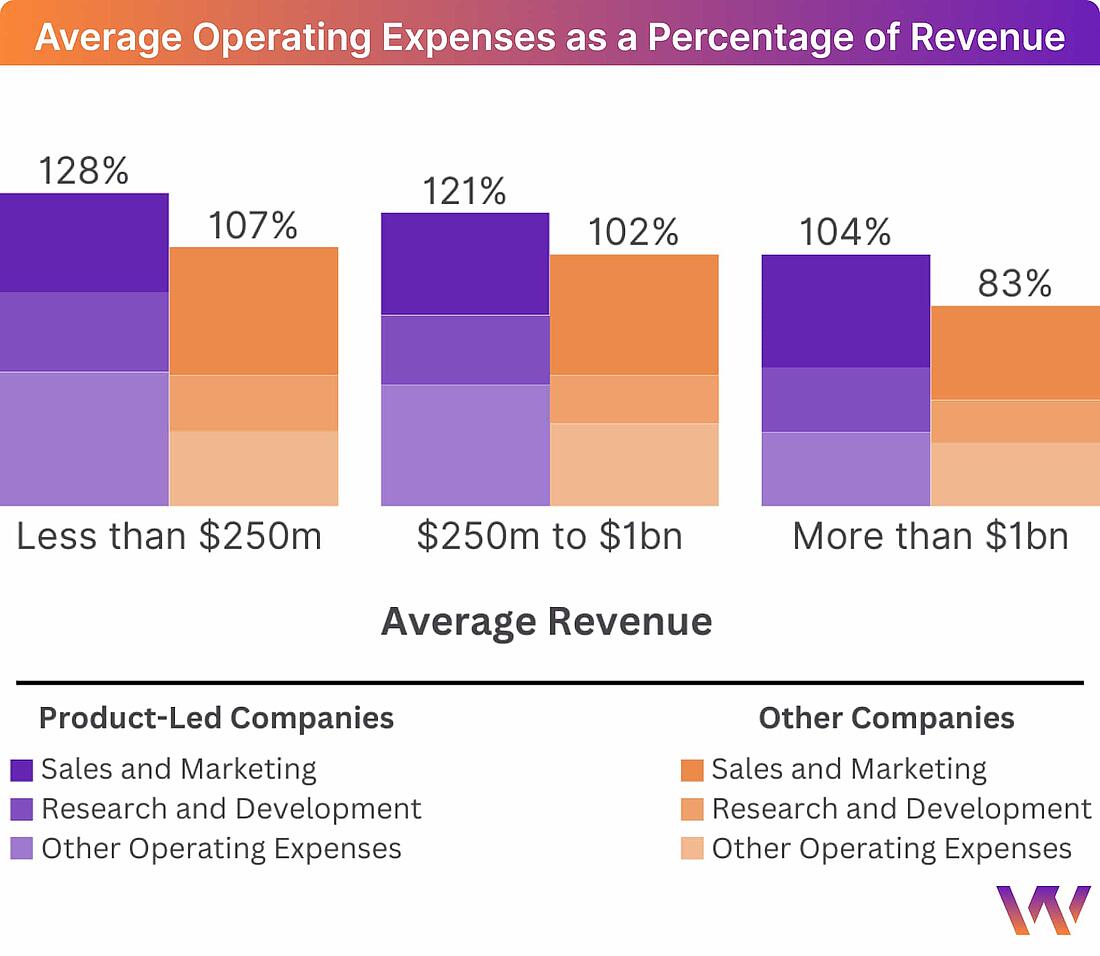- Why Us?
- Features
White Label
For SaaS Platforms & Agencies
Provide our complete analytics suite to your clients, directly within your own interface and with your/their own branding. Discover Analytics-as-a-Service and White Label Analytics. Great benefit, minimal effort.
- Pricing
- White Label
- Success Stories
- Resources
CONTENTS
- What Is Product-Led Growth?
- Why Product-Led Growth?
- How the Product-Led Growth Model Works
- Product-Led Growth (PLG) Vs. Product-Led Marketing (PLM)
- Steps for Building a Product-Led Growth Model
- Example of Successful Product-Led Growth
- Slack
- Dropbox
- Canva
- Figma
- Using Analytics to Ensure Product-Led Growth Success
- Case Study: Cal.com
Product-Led Growth: Let Your Platform Do the Talking

SaaS companies that adopt product-led growth grow more than twice as fast than those that don’t. According to Open View’s 2023 Benchmark Report, they experience 50% year on year growth as opposed to 21% for those that use traditional strategies.
It’s a tantalizing prospect, and particularly given current economic realities that have been limiting SaaS growth prospects since COVID.
If you want to learn more about it, this blog is a great place to start. In it, you’ll learn exactly what product-led growth is, why it’s so effective, and how to create a product-led growth strategy. You’ll also find some fascinating case studies that explain how some of the platforms that we use every day at TWIPLA have built their success on this approach.
It will also table website intelligence as a vital tool in this process. Product-led growth and marketing relies heavily on knowledge gathering about user engagement, and this blog will therefore also explain how businesses can use advanced website analytics to provide them with this important information.
Let’s dive in.
What Is Product-Led Growth?
Product-led growth is a strategy that positions the product itself as the main driver of business development. Simply put, users are offered free access to the product with the expectation that it will be good enough to persuade them to sign up to a paid subscription with minimal outside influence, if any.
Gone are demos, sales calls, or other influences outside of the product, which becomes the main driver of the buying journey and customer experience. It dictates everything, from customer acquisition and engagement to monetization and retention.
It’s a reliable approach that puts the customer right at the heart of business operations, and is built around three key pillars:
- Designing every aspect of the customer journey around the end user.
- Delivering value to customers before capturing market value.
- Investing in the product as a way to build a brand and reputation.
Ultimately, what defines product-led growth is allocating more investment to the product and other operational aspects when compared with alternative business models, with the table below illustrating this shift effectively:
Why Product-Led Growth?
This business strategy has become increasingly popular in recent years and particularly with many Software as a Service (SaaS) companies. Simply put, it’s a fast and effective growth model. For, by allowing customers to try out the product for free, businesses remove any barrier to entry and pull a huge number of users into their conversion pipeline.
Crucially, this all happens without significant investment into sales or marketing and means that businesses can focus their resources on what matters most - making their product better. And by focusing on value - and analyzing product performance from the perspective of its users - businesses can optimize their product or service faster while experiencing better user engagement and satisfaction levels.
The product-led growth framework also lowers customer acquisition costs thanks to low-touch onboarding and support. It also increases scalability potential when compared to traditional sales-driven alternatives since businesses give themselves the ability to acquire new users without having to hire more staff - and increase revenue per employee.
This is all great news at a time when startups are becoming increasingly expensive to grow as a result of economic realities and the saturated nature of the modern marketplace. Businesses often respond to such issues by spending more on marketing, but product-led growth offers an alternative that aligns what they do with customer preferences for independence, self-education, and a frictionless product experience.

How the Product-Led Growth Model Works
Creating a product-led growth strategy is a straightforward process, and you might already have some of the most important elements in place already. Below, you’ll find the full list:
- Free Trials: 43% of product-led companies use free trials to maximize customer acquisition (Gainsight Product-Led Growth Index 2022). These enable prospective customers to try out the full package of features without any financial commitment, reducing barriers to adoption and enabling them to truly understand the product’s value proposition away from unreliable marketing or biased sales consultants.
- Freemium Packages: These have a paid plan conversion rate of 12% - 140% higher than free trials (Productled.com). Free forever plans are another option that product-led businesses can use to pull customers into their platform without opening their wallet. Users are provided with a limited package of features that onboards them into the platform and gives them a taste of the advantages available from more extensive paid plans.
- Independent Onboarding: Product-led businesses build up an extensive library of resources like tutorials, guides, automation aids, and other documentation that new users can use to get to grips with their new plaything without needing to contact human-led sales teams or customer support agents.
- User Experience Optimization: Since it’s the platform that does the talking for your business, it’s important that this product is designed to be as intuitive and useful as possible right from first contact. The goal here is to make the initial user experience compelling enough to drive organic growth through user satisfaction and word-of-mouth recommendation.
- Customer Feedback Looping: This approach relies on continuously listening to users and improving the platform based on their feedback. As such, effective product-led marketing requires a granular understanding of user behavior and preferences, and using these to dictate development decisions.
- Viral Expansion: Products designed around this business strategy will often include built-in features that encourage users to share and collaborate with others. And when done well, this can lead to viral growth as users invite colleagues, friends, or followers to use the platform.
Product-Led Growth (PLG) Vs. Product-Led Marketing (PLM)
Anyone researching this business strategy will come across both product-led growth and product-led marketing. And while they’re not the same thing, they’re closely related concepts that center around leveraging the product as the way to drive business outcomes.
However, they represent different aspects of a company’s strategy.
Product-led growth is the overarching business strategy outlined above. In it, the entire company - from sales to development to the coffee pourer - is aligned around building the product as the primary conduit to growth.
By contrast, product-led marketing (alternatively called product-led growth marketing) is the marketing that supports the aforementioned approach. This makes marketing output another arm of the product’s onboarding documentation, with a focus on explaining how the product works, the pain points it resolves for users, and how easy it is to get up and running. Product-led marketing should also push freemium plans and free trials as a way to get new users onboarded, and then they can see for themselves the advantages of upgrading to a paid subscription.
And so in brief, PLG is the overarching business model while PLM works to promote the product’s role in customer success.
Steps for Building a Product-Led Growth Model
Building a product-led growth model requires taking a systematic approach to integrating your product into the center of everything. It means not selling some aspirational dream or associating the product with beautiful models or lifestyle locations, and in many ways goes back to marketing as it was at the beginning: here’s the product, and here’s what it does.
Of course, it’s slightly more developed than that, and you’ll find below the steps that you can follow to establish a product product-let marketing strategy:
- Identify the Core Value Proposition: Clearly define what makes your product valuable and unique. Understand the problems it solves and how it improves the user's life or work processes. This step is crucial for aligning all marketing efforts around what your product actually delivers.
- Optimize the Product Experience: Ensure that your product is intuitive, user-friendly, and delivers on its promises from the first interaction. This might involve refining the user interface, simplifying the product-led growth onboarding process, or enhancing features that provide immediate value to new users.
- Develop a Freemium or Free Trial Model (or Both): Design a freemium model or a time-limited free trial that allows potential customers to experience the core functionalities of your product without upfront investment. This step is essential to lower the barriers to entry and let the product prove its worth.
- Create Educational Content and Resources: Develop comprehensive guides, tutorials, webinars, and blog posts that help users understand and leverage your product. This content should educate users on both the product itself and the broader context in which it can be used.
- Leverage Product Analytics: Implement tools to track how users interact with your product. Use this data to identify common user paths, drop-off points, and features that are most engaging. This information can guide both product development and marketing strategies.
- Encourage Viral Sharing and Network Effects: Integrate features that make it easy for users to invite others or share their experiences. This could include referral programs, social sharing capabilities, or collaborative features within the product itself.
- Iterate Based on Feedback: Regularly collect and analyze user feedback to continuously refine the product and the marketing approach. This iterative process should aim to enhance user satisfaction and address any barriers that prevent wider adoption.
- Align Sales and Support Teams: Ensure that your sales and customer support teams understand the product-led model and are prepared to assist potential and current users in a way that emphasizes the product’s value. This includes training teams to focus on guiding users to discover the utility of the product rather than making direct sales pitches.
- Measure and Optimize for Key Product-Led Growth Metrics: Define key performance indicators (KPIs) such as user acquisition rates, conversion rates, engagement levels, and customer lifetime value. Continuously measure these metrics and optimize your strategies to improve them.
By following these steps, you can build a marketing model that not only supports but also amplifies the natural growth driven by your product's strengths and user experiences.
Example of Successful Product-Led Growth
Whether you realize it or not, some of the best product-led growth examples are platforms that you could well be using everyday. Let’s have a look at four of the more famous ones.
Slack
Slack was founded in 2009 and quickly grew into the most popular global business messaging platform but you probably already know that. What you might not know is that they’re the preeminent product-led growth company in the world, and the best example for others looking to understand the potential of this strategy.
Thanks to this strategy, they were able to reach a $7 billion valuation in just five years. And if you’re a user, you probably started using it after seeing someone you know using it, getting a personal recommendation, or being invited to use it as part of a business collaboration.
Slack has been so successful here because their product just works. It’s so easy to use and we’re fans here at TWIPLA. They’ve got a free plan and just about anyone can download it and work out how it works quickly. And as a self-service product, users receive regular in-app tutorial snippets that allow them to learn as they go.
Of course, they still have a sales team but these guys focus on helping large enterprise organizations that obviously have more advanced requirements. But Slack has succeeded largely by virtue of a product-led approach, and by using analytics to understand user behavior and improve the product in ways they know their users will love. Enough said!
Dropbox
Like Slack, Dropbox is a leader in its own field. They’re a reliable cloud storage solution with integrated file-sharing and collaboration practices. And like Slack, Dropbox works really well. It’s easy to install, intuitive to use, and rarely has any problems as long as the user’s internet connection doesn’t fail.
They’re also another example of a company that has excelled using a product-led approach to business, with the features helping users to do their business development on their behalf. Sharing and collaboration is integral to the user experience, while the freemium package and referral bonus scheme all motivate users to basically market the product on their behalf.
Dropbox’s success speaks for itself. They now have over 700 million registered users and have increased their revenue more than four times over since 2015. That’s impressive, and yet it’s rare to see an advertisement from them - this growth is all built on a product that has been developed to sell itself.
Canva
Canva sells itself as a free-to-use online graphic design tool and the quality of visuals that users can create is second to none. It also offers a wide range of impressive collaborative features that allow colleagues to work together, share feedback, and share projects effortlessly.
What’s more, the platform’s interactive presentation features make it easy for businesses to improve webinars, demos, and other virtual meetings. These are all highly intuitive to use, and this all works to help the company to retain customers and incentivise them to pay for a higher level subscription.
If you’ve been following, then you’ll already have clocked that all these elements form the basis of their successful product-led growth model. Canva prioritizes user experience before anything, with a mission to make graphic design easy for everyone. The company only launched in 2015, but the Australian company attracted over $2 billion in annualized revenue in 2023 - a level of growth that makes them the envy of tech businesses the world over.
Figma
Figma calls itself the leading collaborative design tool for building meaningful products, and it’s an integral part of our own platform’s development here at TWIPLA. It allows users to seamlessly design, prototype, develop, and collect feedback in one place, making it a one-stop-shop for product development.
The business has been able to set itself apart in a crowded marketplace by building a platform that allows people to easily collaborate, regardless of where they are in the world. This gives Figma inbuilt virality, and means that the company can acquire new customers without any marginal costs whatsoever.
Figma’s product-led growth approach is also reaping dividends. They hit an estimated $615 million in annual recurring revenue (ARR) at the end of 2023, a 45% annual increase. And while their merger with Adobe has fallen through, expect Figma to continue going from strength to strength over the coming years.
Using Analytics to Ensure Product-Led Growth Success
By now, you should understand that product-led growth success requires building a great product. Unfortunately, 42% of businesses claim that their product isn’t ready, making it the biggest reason for not adopting this strategy (Gainsight Product-Led Growth Index 2022).
And building a product that works isn’t enough by itself - it needs to be developed around both actual user behavior and customer feedback. To do this, you’ll need to gain insight into the following areas:
- User Actions Outside Your Website: Analyzing app usage for product-led marketing can provide insights into how users engage with the app, which features drive the most interactions, and which in-app experiences lead to the most conversions.
- Mapping the Funnel: By analyzing key visitor journeys to conversion, businesses can identify where users are dropping off and which routes are most engaging - and to use these insights to optimize these conversion pipelines.
- Cross-Platform Analytics: SaaS companies often have multiple web domains alongside their app and other digital channels, and successful product-led growth requires being able to analyze these different platforms together in one place.
- Data Export and Integration: Being able to take analytics data and to import it into other programs like Power BI enables businesses to get more valuable insights for their funnel map - something that will lead to more informed decision-making for product-let optimization.
Thankfully, these insights are now all easy to obtain thanks to advanced website intelligence platforms like TWIPLA. We provide advanced visitor behavior analytics tools like heatmaps, funnels, session recordings, and event tracking that enable you to understand how users are actually interacting with your website or app. These visualizations make complex data easy to understand, and you can link your different addresses together to get the holistic view of cross-domain tracking that is vital for user behavior optimization.
Our platform also includes a range of visitor communication features. These enable you to collect the user feedback you need, to both confirm insights pulled from other tools, and to discover product issues that you might never have otherwise thought of.
Case Study: Cal.com
Cal.com is an open-source scheduling platform that businesses can use to simplify meeting arrangements, and they’re on a mission to connect a billion people by 2031 through calendar scheduling.
It’s a fantastic productivity app that is popular among tech-savvy software enthusiasts and privacy advocates alike, with advanced customization options, strong workflow automation capabilities, and seamless integration with other platforms.
They’re also a key partner, and are using TWIPLA’s cross-platform analytics to get the insights they need to optimize their user experience across their website and app. They’ve found our session recordings and funnels tools to be particularly vital sources of intelligence, while TWIPLA's granular filtering capabilities and event tracking feature has enabled them to customize analytics to the specificities of their product.
And while still early in the process, we’re excited to see Cal.com going from strength to strength and their impressive growth since 2021 shows that they’re on the right trajectory to join Slack and Dropbox as rock stars in the product-led growth game.
Integrate TWIPLA into Your Product-Led Growth Strategy Today!
We’re also strong advocates of product-led growth, and offer a freemium subscription package as well as free trials on all our pricing plans that are actually cheaper than the cost of the consent management platform you’d need alongside alternative analytics integrations that use cookie-based tracking.
What's more, our advanced cookieless tracking technology means that, in maximum privacy mode, our users are able to legitimately leverage website intelligence under all global laws without needing visitor consent.
And without a cookie banner gatekeeping data collection, you can collect up to 500% more website visitor data, and build far more accurate insights into digital optimization activities.
So sign up for free today, get the insights you need to drive success and test an award-winning platform that has been built around product-led growth principles.
Share article
Get Started for Free
Gain World-Class Insights & Offer Innovative Privacy & Security

You might also like
Enterprise Analytics: Boosting Digital Data Efficiency for Big Businesses 29 February 2024 - by Simon Coulthard
29 February 2024 - by Simon Coulthard
How Agencies Leverage TWIPLA to Drive Growth and Versatility 12 January 2024 - by Simon Coulthard
12 January 2024 - by Simon Coulthard












